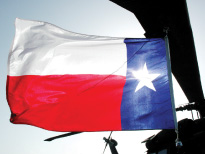When storms blow in, Texas military forces head out
Iuliana Petre - Killeen Daily Herald
2008/08/08
 Aviators of the Texas Army National Guard’s 449th Aviation Support Battalion proudly display the Lone Star flag from the rotor blade of their UH-60L Black Hawk helicopter staged at the Weslaco Texas Municipal Airport during Hurricane Dolly.Photo by Photo by 1SG Lek Mateo, US Army
Aviators of the Texas Army National Guard’s 449th Aviation Support Battalion proudly display the Lone Star flag from the rotor blade of their UH-60L Black Hawk helicopter staged at the Weslaco Texas Municipal Airport during Hurricane Dolly.Photo by Photo by 1SG Lek Mateo, US Army
When back-to-back storms – Dolly and Edouard – recently threatened the coast of Texas and other parts of the state, Texas military forces were alerted to support first responders.
Although military forces – the Texas Army National Guard, Texas Air National Guard and Texas State Guard – are never the first to provide emergency services, soldiers and supplies are moved to points of distribution to ensure that organizations like fire departments, emergency medical services, police, county sheriffs, deputies and judges, are available to support their communities.
“We always think it’s about everybody else,” said Col. Bill Meehan, the Texas military forces spokesperson.
A total of 950 soldiers were alerted to support Hurricane Dolly, and 675 were alerted to support Tropical Storm Edouard.
The first dispatch call for military forces comes from the governor’s Department of Emergency Management office in Austin, an organization that alerts military forces and determines troop and support allocations.
With no more than two or three days to prepare and pre-position assets, military forces remain on alert, ready to perform medical services, conduct search-and-rescue missions, transport and distribute supplies that will reach local residents and provide communications systems to help responders communicate with one another.
Spearheading operations is a command and control unit, the Standing Joint Inter-Agency Task Force, which is trained to work with civilian responders. It is headquartered in Austin.
For the recent storms, the majority of forces came out of Houston, San Antonio and the lower Rio Grande Valley, Meehan said. The forces included: from Houston, the 72nd Infantry Brigade Combat Team, which provided the majority of soldiers for both Hurricane Dolly and Tropical Storm Edouard; three air wings, the 136th Airlift Wing from Fort Worth, the 147th Reconnaissance Wing from Houston and the 149th Fighter Wing from San Antonio; and soldiers from various other Texas State Guard units across the state.
Receiving an alert notification shortly after a natural disturbance’s first sighting and before it develops into a storm, units begin planning and preparing almost immediately so as to ensure that troops and supplies are in place when a storm hits.
Active-duty units are not called in for support unless a natural disaster grows increasingly difficult to manage at the state military forces level.